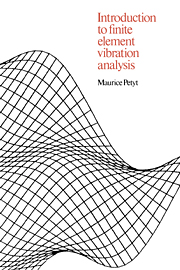Book contents
- Frontmatter
- Contents
- Preface
- Notation
- 1 Formulation of the equations of motion
- 2 Element energy functions
- 3 Introduction to the finite element displacement method
- 4 In-plane vibration of plates
- 5 Vibration of solids
- 6 Flexural vibration of plates
- 7 Vibration of stiffened plates and folded plate structures
- 8 Analysis of free vibration
- 9 Forced response I
- 10 Forced response II
- 11 Computer analysis techniques
- Appendix
- Answers to problems
- Bibliography
- References
- Index
4 - In-plane vibration of plates
Published online by Cambridge University Press: 13 January 2010
- Frontmatter
- Contents
- Preface
- Notation
- 1 Formulation of the equations of motion
- 2 Element energy functions
- 3 Introduction to the finite element displacement method
- 4 In-plane vibration of plates
- 5 Vibration of solids
- 6 Flexural vibration of plates
- 7 Vibration of stiffened plates and folded plate structures
- 8 Analysis of free vibration
- 9 Forced response I
- 10 Forced response II
- 11 Computer analysis techniques
- Appendix
- Answers to problems
- Bibliography
- References
- Index
Summary
Flat plate structures which vibrate in their plane, such as shear wall buildings, can be analysed by dividing the plate up into an assemblage of two-dimensional finite elements, called membrane elements. The most common shapes of element used are triangles, rectangles and quadrilaterals. These elements can also be used to analyse the low frequency vibrations of complex shell-type structures such as aircraft and ships. In these cases the membrane action of the walls of the structures are more predominant than the bending action.
In Chapter 3 it is shown that in order to satisfy the convergence criteria, the element displacement functions should be derived from complete polynomials. In one dimension the polynomial terms are 1, x, x2, x3, …, etc. Complete polynomials in two variables, x and y, can be generated using Pascal's triangle, as shown in Figure 4.1. Node points are normally situated at the vertices of the element, although additional ones are sometimes situated along the sides of the element in order to increase accuracy. (This technique is analogous to having additional node points along the length of a one-dimensional element, as described in Section 3.8.) When two adjacent elements are joined together, they are attached at their node points. The nodal degrees of freedom and element displacement functions should be chosen to ensure that the elements are conforming, that is, the displacement functions and their derivatives up to order (p − 1), are continuous at every point on the common boundary (see Section 3.2).
Information
- Type
- Chapter
- Information
- Introduction to Finite Element Vibration Analysis , pp. 141 - 175Publisher: Cambridge University PressPrint publication year: 1990
